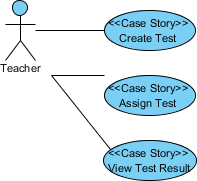Case Study
In order to demonstrate the idea of business goals identification more effectively, we will use a case study to guide you through the whole tutorial. Here is the background information of the case study:
|
With the aim of reducing teachers' workload, Hello World School is planning to introduce an online test system. During a meeting between an analyst and the principal, the principal expresses the requirements of the system to the analyst: The principal wants an online system where teachers can create tests online and then assign to any student at any time. Furthermore, students can take the assigned tests from the system and teacher can assess the students' performance through the system. Most importantly, with this online system, teachers can re-use the tests in the future to save as much time and effort as possible. |
A Use Case Diagram is useful in representing the relationships between different actors (e.g. teachers) and goals (e.g. to re-use the test in the future). Let's see how to draw a Use Case Diagram to visualize the business goals of this case.
What is a Use Case Diagram?
At its simplest, a Use Case Diagram acts as a blueprint that represents how various users interact with the system and to provide an overview of the business goals. There are basically 3 main components to draw a Use Case Diagram, namely, use case, actor and association. Use case is actually simple wordings, usually one word or two that concretely describe an objective user's goal in a system in order to earn measurable results of value. In other words, it is a summary of what the user wants. Moreover, an actor is the participant who interacts with the system to achieve the goal (as represented by a use case) and an association is used to portray the relationship among an actor and a use case.
Benefit of a Use Case Diagram
Since a single system usually involves more than one users and achieve multiple goals, one key benefit in using Use Case Diagram is that it makes the presentation of user needs easier, helping everyone knows what the whole system is about and time for producing detail explanation in words is saved.
Drawing Use Case Diagram
- Open the Use Case Diagram page in UeXceler. If you are not currently opening UeXceler, select UeXceler > UeXceler from the toolbar first, and then open the Use Case Diagram page.

- Let's draw the goals that can be achieved by teacher first. Select Actor from the diagram toolbar.

- Click on the diagram to create an actor.

- Enter Teacher as name and press Enter to confirm the naming.

- Move your mouse pointer over the actor.

- Press on the Resource Catalog button at the top right corner of the shape and drag it out.

- Release the mouse button at the place where you want the use case be created.
- Select Actor -> Use Case from Resource Catalog.

- Enter Create Test as the name of the use case and press Enter to confirm.

- Repeatedly create use cases Assign Test and View Test Result.

- Draw actor Student and a use case Perform Test. Up to now, your use case diagram should look like this.



